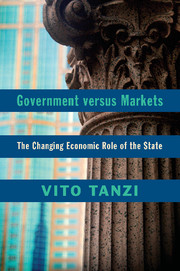Book contents
- Frontmatter
- Contents
- Preface
- PART ONE THE ECONOMIC ROLE OF THE STATE
- PART TWO HISTORICAL REVIEW
- PART THREE THEORETICAL AND ANALYTICAL ISSUES
- 7 Theories of Public-Sector Behavior
- 8 Voluntary Exchange and Public Choice Theories
- 9 The Nordic European Economic Theory of Fiscal Policy
- 10 Policy Tools and Government Roles
- PART FOUR THE OUTCOME OF STATE INTERVENTION
- PART FIVE ON THE ECONOMIC ROLE OF THE STATE IN THE FUTURE
- Notes
- Index
- References
7 - Theories of Public-Sector Behavior
Taxonomy of Government Types
Published online by Cambridge University Press: 07 October 2011
- Frontmatter
- Contents
- Preface
- PART ONE THE ECONOMIC ROLE OF THE STATE
- PART TWO HISTORICAL REVIEW
- PART THREE THEORETICAL AND ANALYTICAL ISSUES
- 7 Theories of Public-Sector Behavior
- 8 Voluntary Exchange and Public Choice Theories
- 9 The Nordic European Economic Theory of Fiscal Policy
- 10 Policy Tools and Government Roles
- PART FOUR THE OUTCOME OF STATE INTERVENTION
- PART FIVE ON THE ECONOMIC ROLE OF THE STATE IN THE FUTURE
- Notes
- Index
- References
Summary
Introduction
In the previous chapters, we have provided information on the growth of public spending over more than a century in several countries and have discussed the impact that various factors, as well as important economists, may have had on that growth. We now turn out attention to the results and the consequences of high public spending and consider various theories that have been advanced by economists to help explain the behavior of governments. In this chapter, we focus on “primal types” of states and offer some classifications that may be of use in assessing ways in which governments behave. We start with Italian contributions that contain seeds for later development in fiscal theory. Except for James Buchanan, and, to a lesser extent, Richard Musgrave, Alan Peacock, and a few others, these seeds have not been fully recognized by non-Italian public finance scholars. However, especially through the work of Buchanan, they have had some limited impact on the public finance literature.
Public finance has been a major field of study, separate from economics, in Italy for perhaps longer than in most other countries. The first chair in public finance was established at the University of Pavia in 1878, and its first occupant was Giuseppe Ricca Salerno, who was the author of one of the earliest public finance textbooks (Salerno, 1880). Chairs in public finance continue to exist today in various faculties (economics, statistics, law, and political science).
- Type
- Chapter
- Information
- Government versus MarketsThe Changing Economic Role of the State, pp. 151 - 168Publisher: Cambridge University PressPrint publication year: 2011



